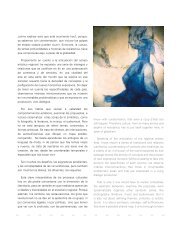yacían ensangrentados en las instalaciones carcelarias. Sesenta y ...
yacían ensangrentados en las instalaciones carcelarias. Sesenta y ...
yacían ensangrentados en las instalaciones carcelarias. Sesenta y ...
You also want an ePaper? Increase the reach of your titles
YUMPU automatically turns print PDFs into web optimized ePapers that Google loves.
Des<strong>en</strong>laces para<br />
profundizar el debate 5.4 Tying Loose Ends for a<br />
Deeper Debate<br />
“La m<strong>en</strong>talidad moderna nació junto con<br />
la idea de que el mundo puede cambiarse.<br />
La modernidad consiste <strong>en</strong> el rechazo del<br />
mundo tal como ha sido hasta el mom<strong>en</strong>to y<br />
<strong>en</strong> la resolución de cambiarlo. La forma de<br />
ser moderna estriba <strong>en</strong> el cambio compulsivo<br />
y obsesivo: <strong>en</strong> la refutación de lo que es<br />
meram<strong>en</strong>te <strong>en</strong> el nombre de lo que podría y, por<br />
lo mismo, debería ocupar su lugar” 37<br />
Como he señalado al principio de este <strong>en</strong>sayo, durante<br />
la última década del siglo pasado, los artistas siguieron<br />
apegados a los valores clásicos afines a la lógica<br />
academicista del arte. Aunque hubo una r<strong>en</strong>ovación<br />
<strong>en</strong> <strong>las</strong> temáticas y soportes de la g<strong>en</strong>eración de los<br />
90s, los criterios formales como el oficio artesanal, la<br />
armonía, variedad, proporción, dominio del material<br />
tradicional y realismo, figuraron como requisitos para<br />
la legitimación de <strong>las</strong> manifestaciones visuales <strong>en</strong> los<br />
espacios institucionales locales. El ambi<strong>en</strong>te de cubo<br />
blanco de la galería o el museo se concebía tanto por los<br />
artistas, como por la crítica, como el terr<strong>en</strong>o idóneo para<br />
armonizar los valores del bu<strong>en</strong> oficio y la dep<strong>en</strong>d<strong>en</strong>cia<br />
de un mercado complaci<strong>en</strong>te que coartó <strong>en</strong> gran<br />
medida el ímpetu original de la experim<strong>en</strong>tación, ya que<br />
bu<strong>en</strong>a parte de la obra se siguió realizando <strong>en</strong> formatos<br />
bidim<strong>en</strong>sionales conv<strong>en</strong>cionales de pequeño y mediano<br />
formato, esto como alternativa de adquisición para<br />
coleccionistas privados que hasta la fecha sigu<strong>en</strong> si<strong>en</strong>do<br />
retic<strong>en</strong>tes a la naturaleza cambiante del arte.<br />
A lo largo de casi dos décadas, desde que inició esa<br />
t<strong>en</strong>d<strong>en</strong>cia, su modelo continúa vig<strong>en</strong>te hoy <strong>en</strong> día. Sin<br />
embargo, algunos de los seguidores de esa tradición<br />
clásica han innovado los cont<strong>en</strong>idos de sus obras gracias<br />
a los cambios socio-políticos experim<strong>en</strong>tados durante<br />
“The modern m<strong>en</strong>tality was born at the same<br />
time than the idea that the world can be<br />
changed. Modernity consists in the rejection<br />
of the world as it has be<strong>en</strong> up to this mom<strong>en</strong>t,<br />
and the resolution of changing it. The modern<br />
way of being is characterized by compulsive,<br />
obsessive change –by the refutation of what it<br />
is merely in the name of what could, and, for<br />
the same reason, should take its place” 37<br />
Like I noted at the start of this essay, during the <strong>las</strong>t<br />
decade of the past c<strong>en</strong>tury artists still stayed faithful to<br />
the c<strong>las</strong>sic values dear to the academicist logic of art.<br />
Although there was r<strong>en</strong>ovation in themes and subjects<br />
by the g<strong>en</strong>eration of the 1990s, formal criteria—such<br />
as craftmanship, harmony, variety, proportion, mastery<br />
of the traditional materials, and realism—were still<br />
considered requirem<strong>en</strong>ts for legitimating visual arts in<br />
the institutional spaces at the local level. The “white<br />
cube” <strong>en</strong>vironm<strong>en</strong>t of galleries and museums was<br />
considered, by the artists as well as the critics, as the<br />
ideal field to harmonize the values of good artistry and the<br />
dep<strong>en</strong>d<strong>en</strong>ce on a complac<strong>en</strong>t market that by and large<br />
inhibited the original drive of experim<strong>en</strong>tation –since a<br />
considerable portion of the art sold was nevertheless<br />
being made in small and medium-sized conv<strong>en</strong>tional bidim<strong>en</strong>tional<br />
format, to be acquired by private collectors<br />
who, to this date, remain retic<strong>en</strong>t before the changing<br />
nature of art.<br />
Throughout six decades, since this t<strong>en</strong>d<strong>en</strong>cy started,<br />
its model has stayed in force to this day. However, some<br />
of the followers of that c<strong>las</strong>sic tradition have innovated the<br />
subject of their work thanks to the sociopolitical changes<br />
experim<strong>en</strong>ted during all those years. As for the forms,<br />
37 Baumant, Zygmunt. Vidas desperdiciadas. La modernidad y sus parias, Paidos Estado y sociedad, Barcelona 2005, Pág. 30<br />
Bauman, Zygmunt. Vidas desperdiciadas. La modernidad y sus parias, Paidos Estado y sociedad, Barcelona 2005, p. 30 [Translator’s Mea Culpa: This book was<br />
originally published in English. Since it was not available to me, I had to instead provide an approximate English version of the Spanish translation. Traduttore,<br />
tradittore.]<br />
31 33 35 37 39 41 43 45 47 49 51 53 55 57



